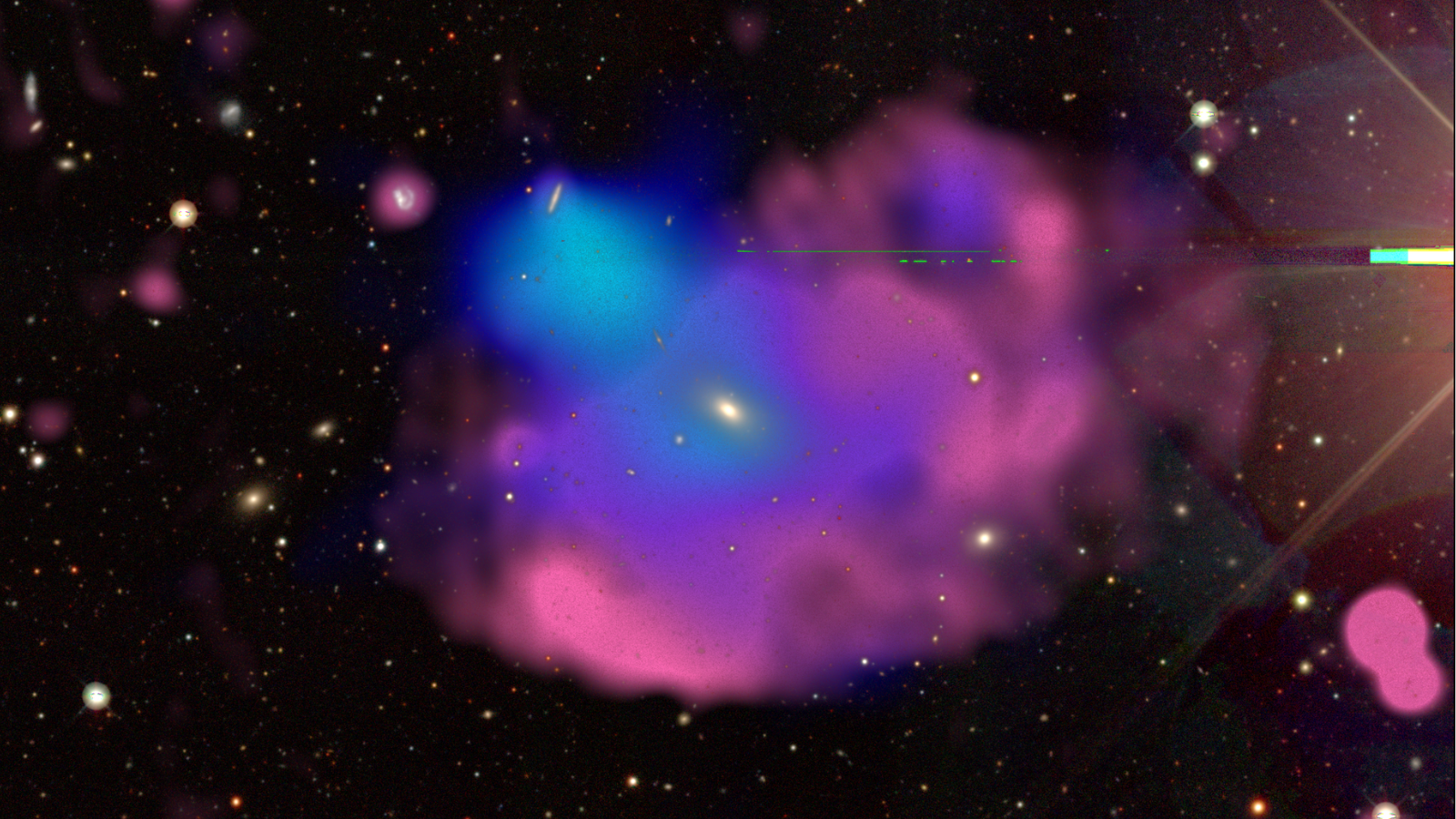ORCs in space! Astronomers find another vast odd radio circle in 'completely unexpected discovery'
"It's a completely unexpected discovery, not predicted by the physics we already know, and therefore revealing a gap in our knowledge."

Astronomers have discovered another mysterious and massive circle of radio light in space. The strange and vast circle of light is an example of an ORC (Odd Radio Circle), the origins of which are currently unknown.
ORCS, first discovered in 2019, are so vast they can be 10 times the width of the Milky Way, thus encompassing entire galaxies.
The newly found ORC, designated ORC J0219–0505, was discovered in data from the MIGHTEE survey conducted by the MeerKAT radio telescope located in the Meerkat National Park in the Northern Cape of South Africa. The 371,600 light-year-wide ORC seems to be associated with the elliptical galaxy WISEA J021912.43–050501.8. It has features that seem to set it apart from other ORCs, including the fact that it appears fainter and that details of its structure reveal it leans to one side.
"Odd Radio Circles: Circles of radio emission found around distant galaxies that we still don't understand," lead researcher and Western Sydney University astronomer Ray Norris told Space.com. "It's a completely unexpected discovery, not predicted by the physics we already know, and therefore revealing a gap in our knowledge.
"So we hope these will tell us something new about how galaxies form and interact."
As mentioned above, ORC J0219–0505 seems to differ from other previously discovered ORCs, which has at least answered one question about this strange astronomical phenomenon.
"All the ORCS we had previously discovered were very similar. We weren't sure whether this was because all ORCS really are similar or whether it was a selection bias in our detection methods," Norris said. "This new ORC tells us it was indeed a selection effect."
The astronomer added that the faintness of this ORC is consistent with ORCS coming in a range of sizes and brightnesses. He compares this to the variations seen in radio galaxies, which have giant radio emission regions that extend well beyond their visible structure.
Get the Space.com Newsletter
Breaking space news, the latest updates on rocket launches, skywatching events and more!
ORC birth controversy
Unsurprisingly, for a mysterious newly discovered astronomical phenomenon, scientists have a few different ideas of how ORCs are formed.
Norris explained that one thing that is almost certain is the fact that the radio emission behind ORCs is the emission of so-called "synchrotron radiation."
This arises from electrons that have been accelerated to high energies and high speeds by a shock wave. The debate around ORCs concerns the source of these powerful shockwaves.
"There are two main schools of thought as to what causes this," Norris explained. "One is that the circles of ORCs are caused by spheres of shocked gas surrounding a galaxy."
The astronomer said that in this case, the ring we see representing an ORC is actually just the cross-section of an expanding sphere caused by a shock wave.
This shock wave could be the result of a cosmic collision, either two galaxies colliding and merging or even two supermassive black holes merging.

Alternatively, Norris said that the rings could be caused by a plane shock wave from another source crossing a dead radio lobe from a supermassive black hole.
These lobes emerge from each side of feeding supermassive black holes and spread out to incredible distances.
In this case, Norris said that as the plane shock wave intersects the roughly spherical outer edge of the remnant lobe, it creates a ring of accelerated electrons that generate synchrotron radiation.

The fact that ORC J0219–0505 differs from previously discovered ORCs could hint at which of these creation models is the accurate one.
"The offset between the center of the ring and the host galaxy isn’t easy to explain in the merging supermassive black hole model," Norris explained. "That was my favorite model, so I’m not very happy about this!"
Norris pointed out that the discovery of ORC J0219–0505 shows there is "still a fair way to go" before scientists understand ORCs.
The astronomer said that in addition to investigating WISEA J021912.43–050501.8, this ORC's galactic home, further with a large optical telescope, the team will also hunt for more ORCs as they attempt to solve this cosmic curiosity.
The team's research is reported in preprint form on the repository site arXiv.
Join our Space Forums to keep talking space on the latest missions, night sky and more! And if you have a news tip, correction or comment, let us know at: community@space.com.

Robert Lea is a science journalist in the U.K. whose articles have been published in Physics World, New Scientist, Astronomy Magazine, All About Space, Newsweek and ZME Science. He also writes about science communication for Elsevier and the European Journal of Physics. Rob holds a bachelor of science degree in physics and astronomy from the U.K.’s Open University. Follow him on Twitter @sciencef1rst.









